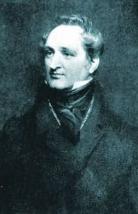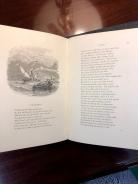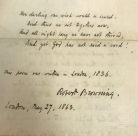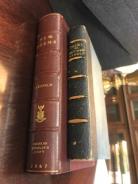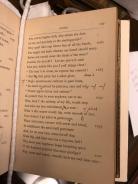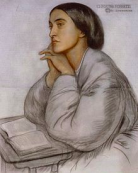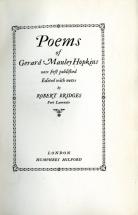Victorian Poetry (Spring 2019): Digital Timeline
Created by Joshua King on Wed, 01/09/2019 - 12:17
Part of Group:
Students will each create one entry related to their rare-item projects.
Note to students: please see the "Digital Timeline and Map Guideliens" on Canvas.
Timeline
Chronological table
| Date | Event | Created by | Associated Places | |
|---|---|---|---|---|
| 1827 to 1873 |
The Copyright of "The Christian Year"Published in 1827, "The Christian Year" was primarily used alongside the Bible and Book of Common Prayer for every Sunday in the calendar year, including entries for the days leading up to specific holidays, such as Easter. "The Christian Year" also contained entries for morning and evening meditations. Its author, John Keble, passed away in 1866 - "The Christian Year" outlived him by less than half a century, fading almost entirely from popular consciousness shortly after World War I. |
Ileyah Tovias | ||
| 1832 to 1842 |
The "Ten Year's Silence"Alfred Tennyson did not publish any poetry for 10 years of his life, and this period of time became known as Tennyson's "Ten Year's Silence." This period began in 1832, following the publication of his second book of poetry, Poems, which was received very negatively by critics and the public. Distraught by this unfavorable criticism, he began revising these poems, slowly and meticulously. However, this silence was not only the result of this criticism, but also the result of the death of his friend, Arthur Hallam. Hallam's death plunged him into a serious state of depression, which heavily impacted the pacing of his revisions and the content of his writing as well. Tennyson would not publish until 1842, and the criticism of his second edition of Poems was much more positive and better received by the public. |
Cristina Pierce | ||
| Autumn 1833 |
The surprising death of Arthur Henry HallamArthur Henry Hallam died of a ruptured aneurysm on September 15, 1833. Arthur Henry Hallam was twenty-two years old. His death was one of the most significant events of Alfred, Lord Tennyson’s life. Tennyson spent the next seventeen years writing In Memoriam A.H.H., sustained lyric verse which would eventually be the reason Tennyson was offered the position of Poet Laureate. In Memoriam is Tennyson’s attempt to memorialize Arthur, but dealt with universal themes such as grief, doubt, remembrance, and philosophical questioning. While In Memoriam A.H.H. is Tennyson’s most popular poem written about Hallam, works such as "Ulysses" and "St. Simeon the Stylites" (both from his 1842 volume of poetry) also reflect Tennyson’s feelings after Arthur’s sudden death. |
Nikki Thompson | ||
| The end of the month Autumn 1846 to The end of the month Summer 1861 |
Elizabeth Barrett Browning's Move to FlorenceAfter secretly eloping, Elizabeth and Robert Browning moved to Florence, Italy in 1846 when Elizabeth's father discovered her marriage and disowned her. This move would be mostly permanent for the Browning family, except for a short move to Siena before Elizabeth's health declined, which ultimately forced them to move back to Florence. While living in Florence, Elizabeth created the first edition of Aurora Leigh, her longest work, which first appeared in 1856-1857. It was one of her last works published before she passed away due to unexplained illness. Florence would be one of the most dear and inspired places for Elizabeth Barrett Browning. |
Ellen Ezell | ||
| 1848 |
When Elizabeth Barrett Browning published "The Runaway Slave at Pilgrims' Point"Elizabeth Barrett Browning first published "Runaway Slave at Pilgrim's Point" in The Liberty Bell officially in 1847, even though the liberty bell book cover says 1848. The Liberty Bell was published in Boston by the Boston Female Anti Slavery Society because it was such a great reminder of the atrocities of slavery that were still going on in New England at that time. |
Destiny Reynolds | ||
| 28 Jun 1854 to 1896 |
"From the Antique" from New Poems by Christina Rossetti, Collected by William RossettiThis photograph of "From the Antique," written by Christina Rossetti in 1854, is found in the book New Poems (published in 1896). New Poems is a collection of works that were written by Christina Rossetti, but not published or collected in her lifetime. Her brother, William Rossetti, found many of them in a range of seventeen notebooks of hers that she had composed by her mid-thirties. Her brother, William Rossetti, collected them after her death, as there was a large amount of public press and eulogy surrounding her death. He called her one of the most important figures in 19th century British poetic literature. In this poem, Rossetti expresses an unnamed Victorian woman's feelings of frustration and alienation, which she herself might have at times shared. Many suspect that the reason this poem was never published was due to the undeniable critique it would have likely endured coming from a woman's perspective. |
Parker Burk | ||
| 1857 to 1860 |
Poems by Alfred Tennyson - UlyssesPoems by Alfred Tennyson is a beautiful volume that was published in 1857 in London, England. Interestingly, three years later it was republished in 1860 by Bradbury and Evans, Printers, Whitefriars. It is known that revisions were made to some of the poems in this edition, and they were probably being made in this three-year period between the completion and the publication. This brings up many questions, one of which has to do with who wanted to make changes, Tennyson himself or his publishers? |
Nicole Mitchell | ||
| Spring 1862 to May 1862 |
Gobin Market and Other Poems PublishedEarly in 1862, Christinna Rossetti publishes Goblin Market and Other Poems. Periodicals start writing about her collection of poems soon after it comes out. The Atheneaum's review was published on April 26th, and the Saturday Review of Politics, Literature, Science, and Art publishes their review of her volume on May 24th. The reviews being so soon after Rossetti's publication help modern readers get an idea of what readers during Rossetti's time period might have thought about the poem. |
Abbey Haines | ||
| 27 May 1863 |
Fair Copy Version of "Porphyria"Composed several decades after its original publication in 1836, Robert Browning inscribed a hand-written fair copy version of "Porphyria" in 1863. The significance of this 1863 version comes from the fact that Robert Browning had only moved back to London two years prior in 1861, following the death of Elizabeth Barrett Browning. This signifies the 1863 fair copy version as the first preserved edit made to "Porphyria" since 1842, shortly before Browning's departure to Italy (1846). |
Ryann Wong | ||
| 1867 |
The Publication of Matthew Arnold's "Dover Beach"Matthew Arnold initially published one of his most famous poems, "Dover Beach," in a collection of poems titled New Poems during the year 1867. The date here is significant because Arnold is believed to have written the poem back in the early 1850s (Oxford Dictionary of National Biography). A nearly twenty-year gap separates the supposed first draft to its first edition publication. "Dover Beach" considers how faith might return in an altered form after the influence of new scientific discoveries, and it stands to reason that the political and religious climates in London during the late 1860s better fit the thematic subject of Arnold's poem than the early 1850s. |
Laura Southern | ||
| 7 May 1882 |
Robert Browning's Masterpiece, The Ring and The BookOriginally published in 1868, The Ring and The Book, renowned as Robert Browning's greatest work, is a twelve-book series of monologues by characters connected to a 1698 Italian murder trial, using Browning's famous dramatic monologue form. Through the testimony and trial by correspondence of Count Guido Franceschini, we see a fine analytical piece containing philosophical, psychological, and social criticism. The image selected comes from a personal second edition copy of Browning gifted by the Browning Society on May 7, 1882, the poet's birthday, notably fourteen years after its original publication. We see his marks in Book Eleven, Count Guido's second and final testimony, in which he reveals his truthful ideals. The rare artifact presented contains a plethora of corrections, and subsequently exposes an aged Browning (70 years old) continuing to perfect his 21,000-line masterpiece. The artifact testifies to the incessant process of editing the poet goes through years after the original edition was published. |
Mason McLain | ||
| 1885 |
Christina Rossetti Publishes "Time Flies: A Reading Diary"Christina Rossetti published Time Flies: A Reading Diary under direction of the Tract Committee. The Tract Committee is tied to the Society for Promoting Christian Knowledge in London. The use of this publisher is consistent considering the form and content of this collection: highly devotional and introspective. Throughout the collection, Rossetti has the reader consider explicitly spirtual ideas as well as seemingly mundane experiences. This work has multiple poems and entries concerning nature and humanity's relationship to nature. The publishing of this work at this time was relevant, as Darwinian thought and ideas were circulating and challenging Orthodox Christianity. Rossetti offered a model for how Christians should begin to reconcile the realities of nature and God. |
Marisa Mulloy | ||
| 1889 to 1918 |
The 30 Years that Stand Between Hopkins and His AudienceGerard Manley Hopkins passed away in 1889, and yet the first substantial publication of his poetry was not until nearly 30 years after his death, in 1918. Many of his poems were published within The Poems of Gerard Manley Hopkins, now first published. Edited with notes by Robert Bridges. What caused this major gap in time between when his work was able to capture an audience? Robert Bridges, a friend of Hopkins and also the poet laureate who published his work, is the main reason why this release took so long. He may have thought that the Victorian public was not ready for the uniqueness of Hopkins’s work. He certainly was outspoken about his frustrations with Hopkins’s poetic techniques in his concluding notes in the volume. Although he was the agent that gave Hopkins’s work a wider audience, his hesitations about it are obvious. The 30-year gap reveals Bridges’s uncertainty and misunderstanding surrounding Hopkins’s intention to convey feeling through the rhythm, structure, and rhyme of his poetry. This gap also displays the power the Hopkins's works hold, for although this collection was published well after his lifetime, his work continues to impact and shape readers and poets to this day. |
Shaye Widger |


